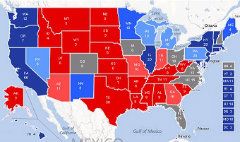 Barring any unforeseen event, there aren’t enough undecideds to sway these uncertain elections. Persuasion is over now. The embers are being fanned with advertising dollars, but the electorate is now fairly immune to the heat from either side. The negative ads won’t do the heavy work of GOTV.
Barring any unforeseen event, there aren’t enough undecideds to sway these uncertain elections. Persuasion is over now. The embers are being fanned with advertising dollars, but the electorate is now fairly immune to the heat from either side. The negative ads won’t do the heavy work of GOTV.
The tea leaves from the polls give a very murky outlook. Republicans told us weeks ago that the polls are unreliable and biased. They were certainly not giving the news that they wanted to hear. For a while they were apoplectic; then curled up in the fetal position. When the polls swung their way, they suddenly became prophetic. But the truth is we (except maybe Nate Silver) won’t know what they mean until midnight Tuesday.
The benefit of the ad deluge right now is nearly zero compared to ads run in June or July. Dr. Quentin Kidd (Christopher Newport University) suggests that was factored into the strategy of the Obama campaign. The campaign had ads up at that point in all the swing states because they wanted to set the stage early. Everyone knew that by fall the ads would be ubiquitous to the point of being indistinguishable. This strategy may prove the difference in this race.
In a conversation with Cathy Lewis on WHRV last week, Kidd concurred with the view that we have reached the point of political ad saturation. But, he said, we are in an arms race from which no campaign can pull back without demonstrating some sort of weakness; suggesting maybe the financial support has gone (see George Allen’s contribution to himself). And just today a very expensive 20 page, glossy, Obama mailer arrived from OFA.
The differences between the polls this year are generally within the margins of error. What makes those differences? Republicans and their talk radio rationalists point to a liberal media or polling bias, but there are more practical matters that influence the results.
Polls are supposed to harvest essentially random input. But part of that is a function of who picks up the phone and that is constantly changing. It is influenced by the time of day the calls are made and who would be home at those times to answer (or choose not to answer). Another change to the process of polling is the transition from land lines to cell phones. There are regulations affecting the choice of user. Regulations make calling land lines much easier: automated machines can make these calls; not so with cell phones. That means a human must dial the area code and number, increasing costs significantly.
Let’s think about that. The number of people using cell phones is growing and that number skews younger than the land line users. In fact there may be a demographic segment that is simply not included in the polls. And the internet is an imperfect alternative for many reasons.
Dr. Kidd says that phones will continue to be used for the foreseeable future but that there will be a shift to cell phones over time. Currently he uses a 75/25 split land line to cell phone and 10 to 12 percent of the cell phone users are cell phone only users. That, according to Kidd, characterizes is the state of the art for now. Cell phone users are younger, more mobile; meaning a land line sample is older and less mobile.
All this makes the poll results hazier. So interpreting them is a fine art and requires a more thorough analysis of the run-up to the election. The ad saturation effect here at the end of the campaign is likely good for democracy. It makes it less likely that voters will use these 30 to 60 second sound bites as the basis for a decision on which way to vote. But it is somewhat disturbing that so many in the cell phone sample set are using the Daily Show and the Colbert Report as a primary source of information; or is it?
“There is some research on the effects of the(se) shows, the Daily Show in particular, on political knowledge and demonstrates that political knowledge is improved by watching those shows. So, that’s a commentary on our news programs; if you can watch a comedy program and your political knowledge is higher.
“But the question is: Why? I think what you just pointed out: Jon Stewart and Stephen Colbert take a very critical look at everything. And I think what comes out the other end of that critical look is a better sense of what is reality. And I think that is why some people find them, in some ways, more beneficial to understanding what is really going on.” – Dr. Quentin Kidd, Department Chair, Christopher Newport University
Interpret that as you may. The potentially underreported demographic is getting its news from Stewart and Colbert.
Finally, the October surprise the bloviating talk show hosts predicted would be a cynical Obama maneuver to allow him to “look Presidential” instead became something more of what they might interpret providential. Sandy, very likely powered by the immoral environmental stewardship Republicans have come to call “free market forces,” set the stage for Obama’s very competent Presidential performance.
So the election is really already all over except the GOTV. There is nothing more important than this GOTV effort for the President and for Tim Kaine in Virginia; down to the last identified strong D.
But there is the undercurrent of another campaign being waged: the continued campaign to delegitimatize President Obama. This one works both ways for Republicans. Win or lose, it accelerates a retrenchment to the past or it puts the brakes on progress. That could mean a pyrrhic victory for our President.
The Berra adage must be adapted for Obama’s next 4 years: It isn’t over even when it’s over.




![Monday News: Trump Continues to Serve His Master Putin; “Troops on the streets, a polarized country and climbing prices: welcome to Trump’s ‘golden age’”; “Whistleblower says [Trump DoJ] has undermined the rule of law”; “Trump posts AI video showing him literally dumping shit on America”](https://bluevirginia.us/wp-content/uploads/2025/10/montage1020-238x178.jpg)








